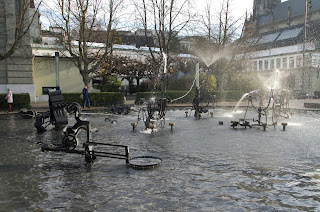 |
| St. George killing the dragon from a distance |
We were in Basel to begin our tour down the Rhine River to
Amsterdam. Basel sits at the uppermost navigable point on the river and at the
intersection of France, Germany and Switzerland. One resident told us that the
best financial arrangement is to live in Germany, shop in France, and work in
Switzerland. Our arrangement here in Vancouver is to live in Washington with no
income tax and shop in Oregon with no sales tax. Of course it is never really
that simple. Anything delivered or licensed will still get the Washington sales
tax and if you want to live in Washington and work in Oregon, you will pay the
income tax AND fight the traffic.
 |
| Christmas markets are about socializing with friends |
We took maximum advantage of our time in Basel with a tour
of the Rathaus (town hall), a visit to the Munster, three hours in the cultural
museum (Basel calls itself the cultural capital of Switzerland with its 30+ museums),
and a walking tour of the city after checking in the our cruise ship. Or course,
we also had a splendid fondue dinner and spent a couple of hours wandering the
Christmas market.


We were fortunate to arrive on Thursday when we could take
advantage of the weekly evening tour of the Rathaus. The guide told us it would
be in German, but we agreed that just seeing the place would satisfy us. As it
turned out the other two couples were fluent in English and offered to listen
in English so we could get the full tour. Very nice of them. The Rathaus was
built in 1503. The new bishop refused to grant Basel a constitution, so the
city showed him its power by building this beautiful new city hall. The city
had become the eleventh member of the Swiss Confederation in 1501 and would end
its Catholic connection in 1529 when the city became Protestant.
 |
| The inner courtyard of the Rathaus |
 |
| Justice in the center |
The inside and outside of the building were built and
decorated to educate and impress. One of the large paintings inside shows
Solomon’s decision to cut the baby in half to settle the dispute over its
motherhood. Another shows the evils of justice only for the rich. The most
interesting artifact is the statue of justice that adorns a wall of the inner
courtyard. It had been a statue of Mary. Taken from a church, the builders
saved money by simply adding the scales of justice and neglected to provide a
blindfold or remove the crown.
 |
| Solomon's justice |
 |
| The original document when Basel joined the Confederation |
The Munster is a fine
example of the late-Romanesque/early-Gothic style. The façade includes an
interesting statue of St. George slaying the dragon. The two towers are
different, not because they were constructed at different times, but because
one of them housed a city guard for many years when Basel was in danger.
Erasmus, the Dutch philosopher who lived in Basel for much of his life is
buried here.
The cultural museum had an interesting display of decorated
Sicilian carts which were used until only a few years ago. I imagine they are
still used in some places today. They also had a fascinating display of early
anthropoligists who had traveled to then remote parts of the world study
cultures. Photographs and artifacts showed both their findings and their
lifestyles as the lived in these remote places.
 |
| Sicilian carts |
 |
| A beautiful stringed instrument in the musuem |
 |
| Fountain designed by iron sculptor Jean Tinguey |
 |
| Clean fresh water spout. I wish we had some fountains like this. |
 |
| This ferry uses the river current for power. Note the cable stretched across the river. The cable from the ferry slides along as the river current pushes the ferry across the river. |
 |
| The three kings banged the staffs on the floor whenever a donation was made. It was a steady din as people walked by. |
 |
| Not sure who this is, but I liked the colorful statue on the pedestal. |



























No comments:
Post a Comment